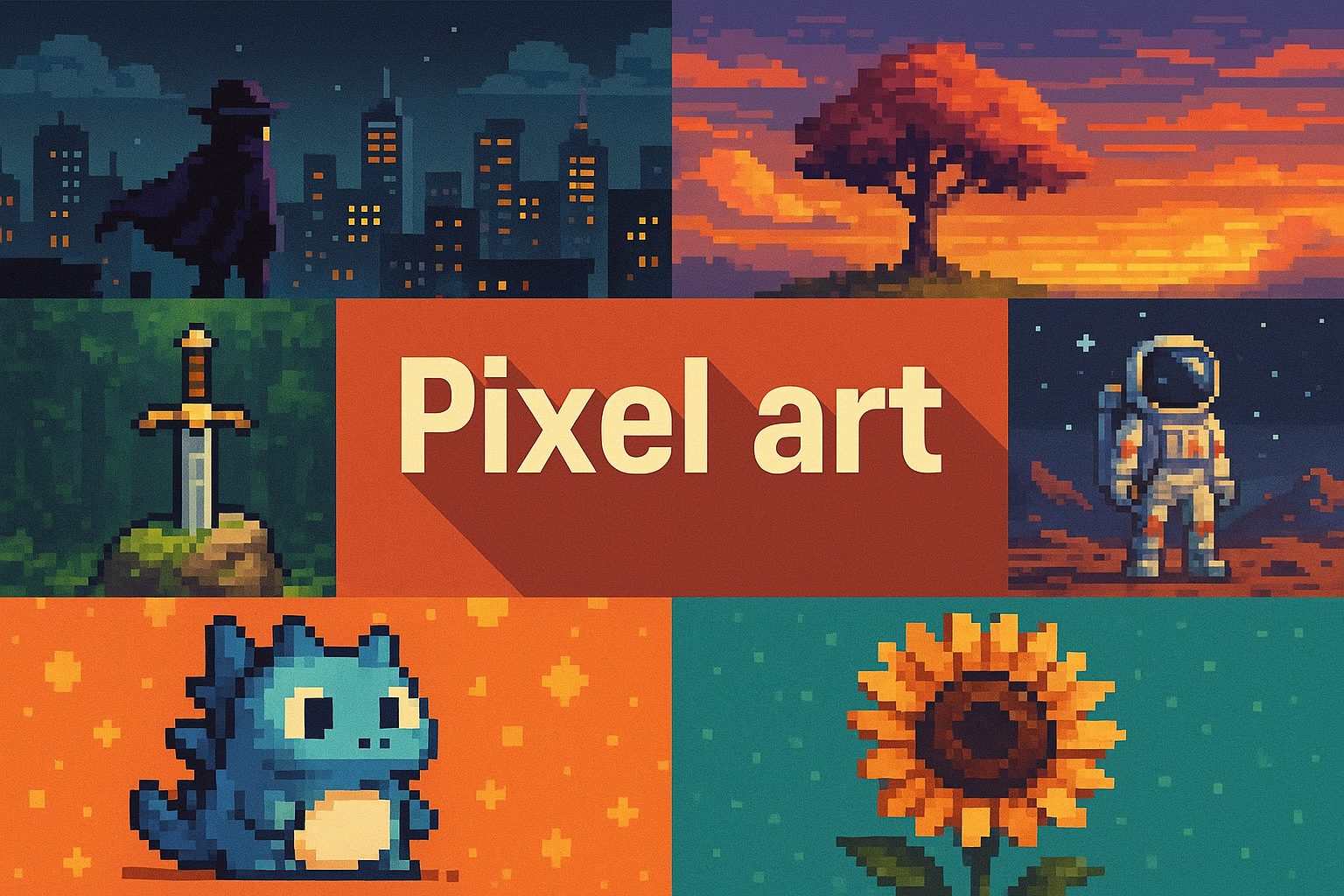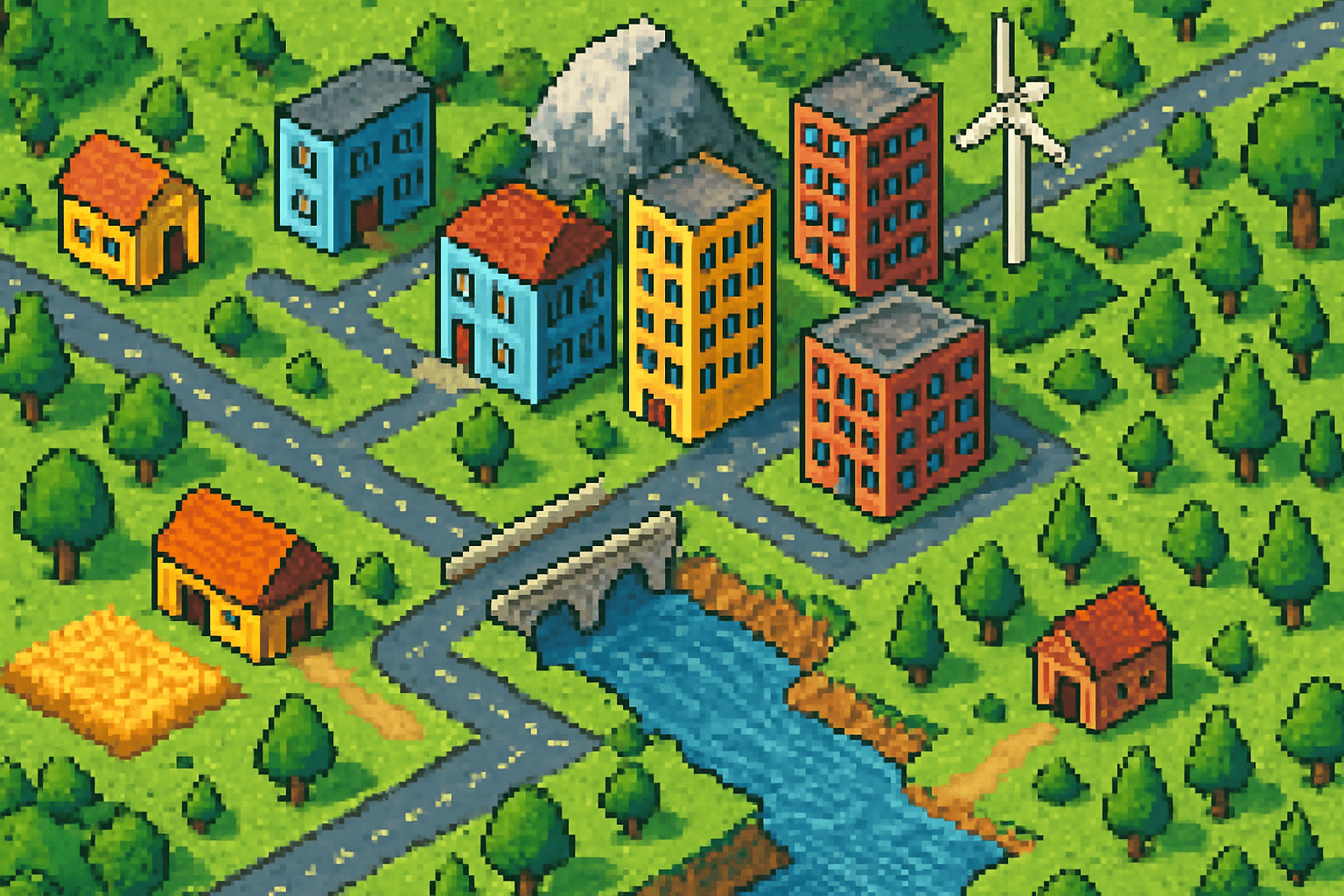
Pixel art
Pixel art is a form of digital art, where images are created and edited on the pixel level. The art style is often characterized by its blocky, pixilated look.
AOI thinking about Pixel art [+_~]-/
Overview and Quickfacts
Pixel art is a form of digital art, where images are created and edited on the pixel level. Pixel art is often used in video games and is characterized by its blocky, pixilated look.
Can understand it also, as:
Sprite art, 8-bit art, bitmap art
Categorize it as:
Impressionism, Modernism
.: Dreaming :.
holds a HAIKU for the art style
:. Thought is power .:
Detailed Description
Pixel art is a form of digital art, created through the use of software, where images are edited on the pixel level. The term pixel art was first used by graphic designers in the late 1970s. Pixel art is often associated with 8-bit and 16-bit graphics, as seen in video games from the 1980s and 1990s. However, pixel art can be created with any color depth and any palette. Pixel art is a very precise art form, where each pixel is placed deliberately. This results in images that are often blocky and pixilated. Pixel art is used in a variety of genres, including platformers, RPGs, and strategy games. Some well-known examples of pixel art include the Super Mario series, The Legend of Zelda: A Link to the Past, and Final Fantasy VI. Famous pixel artists include eboy, who is known for his detailed and intricate cityscapes, and Cory Arcangel, who often uses found images and video game sprites in his work.
.. beep, beep, beep ..
<START OF TRANSMISSION>
1. Pixel art is a form of digital art, where images are created and edited on the pixel level. 2. Pixel art dates back to the early days of video games, when limited graphical capabilities meant that images had to be made up of small pixels. 3. Today, pixel art is used both in video games and as a standalone art form. 4. Pixel art can be created using various software programs, but is often created using simple drawing tools such as MS Paint. 5. The pixel art style is often associated with retro video games, as well as 8-bit and 16-bit graphics. 6. Pixel art often uses a limited color palette, which can give it a distinctive, retro look. 7. Pixel art can be used to create both static images and animated graphics. 8. Pixel art often uses a grid system to help with the creation of images. 9. Images in pixel art can be zoomed in on to show the individual pixels, which can be a distinctive feature of the art form. 10. Pixel art can be created by hand, or by using automated tools. 11. Some pixel artists use a technique called dithering to create gradients and shading effects. 12. Pixel art can be used for both artistic and functional purposes. 13. For example, pixel art can be used to create sprites for video games, or to create detailed illustrations. 14. Pixel art often has a blocky, pixilated look which can be intentional or due to the limitations of the medium. 15. Pixel art can be created in a number of different ways, including using sprites, tiles, or by drawing directly on the pixel grid. 16. Pixel art can be saved in a number of different file formats, including PNG, GIF, and JPG. 17. Pixel art can be shared online or used for commercial purposes. 18. Some pixel artists use software programs to create 3D pixel art. 19. Pixel art can be used to create logos, icons, and other graphic design elements. 20. Pixel art is a popular art form among gamers and retro enthusiasts.
<EOF>
.. robbel bob
Visual Examples from our image gallery
Coming soon, we are so slow .. might never come
Artists, Paintings, and more
(be aware, can be highly speculative)
Artists (be aware, speculation possible):
1. Robert Crumb (b. 1943) 2. Richard Hamilton (1922-2011) 3. Andy Warhol (1928-1987) 4. Roy Lichtenstein (1923-1997) 5. Keith Haring (1958-1990) 6. Jean-Michel Basquiat (1960-1988) 7. George Segal (1924-2000) 8. Edward Hopper (1882-1967) 9. John Baldessari (b. 1931) 10. Richard Diebenkorn (1922-1993) 11. Wayne Thiebaud (b. 1920) 12. Willem de Kooning (1904-1997) 13. Jackson Pollock (1912-1956) 14. Mark Rothko (1903-1970) 15. Barnett Newman (1905-1970) 16. Clyfford Still (1904-1980) 17. Ad Reinhardt (1913-1967) 18. Josef Albers (1888-1976) 19. Paul Klee (1879-1940) 20. Wassily Kandinsky (1866-1944) 21. Piet Mondrian (1872-1944) 22. Kazimir Malevich (1878-1935) 23. Lyubov Popova (1889-1924) 24. Alexandra Exter (1882-1949) 25. Natalia Goncharova (1881-1962) 26. Olga Rozanova (1886-1918) 27. Varvara Stepanova (1894-1958) 28. El Lissitzky (1890-1941) 29. Vladimir Tatlin (1885-1953) 30. Malevich (1878-1935)
Artworks (be aware, speculation possible)
1. “The Great Wave off Kanagawa” by Katsushika Hokusai (1829-1833) 2. “The Hay Wagon” by Pieter Bruegel the Elder (1565) 3. “The Harvesters” by Pieter Bruegel the Elder (1565) 4. “The Tower of Babel” by Pieter Bruegel the Elder (1563) 5. “The Triumph of Death” by Pieter Bruegel the Elder (1562) 6. “The Wedding Dance” by Pieter Bruegel the Elder (1566) 7. “The Peasant Wedding” by Pieter Bruegel the Elder (1568) 8. “The Peasant Wedding Feast” by Pieter Bruegel the Elder (1568) 9. “The Hunters in the Snow” by Pieter Bruegel the Elder (1565) 10. “The Return of the Herd” by Pieter Bruegel the Elder (1565) 11. “The Fall of Icarus” by Pieter Bruegel the Elder (1558) 12. “Netherlandish Proverbs” by Pieter Bruegel the Elder (1559) 13. “The Census at Bethlehem” by Pieter Bruegel the Elder (1566) 14. “The Beggars” by Pieter Bruegel the Elder (1568) 15. “The Blind Leading the Blind” by Pieter Bruegel the Elder (1568) 16. “The Parable of the Blind” by Pieter Bruegel the Elder (1568) 17. “The Parable of the Lost Sheep” by Pieter Bruegel the Elder (1568) 18. “The Parable of the Prodigal Son” by Pieter Bruegel the Elder (1568) 19. “The Parable of the Sower” by Pieter Bruegel the Elder (1568) 20. “The Parable of the Wheat and the Tares” by Pieter Bruegel the Elder (1568) 21. “The Seven Deadly Sins” by Pieter Bruegel the Elder (1558) 22. “The Seven Virtues” by Pieter Bruegel the Elder (1559) 23. “The Allegory of Gluttony and Lust” by Pieter Bruegel the Elder (1562) 24. “The Triumph of Death” by Pieter Bruegel the Elder (1562) 25. “The Conversion of St. Paul” by Pieter Bruegel the Elder (1567) 26. “The Conversion of Saul” by Pieter Bruegel the Elder (1567) 27. “The Temptation of St. Anthony” by Pieter Bruegel the Elder (1567) 28. “The Temptation of Christ” by Pieter Bruegel the Elder (1567) 29. “The Adoration of the Magi” by Pieter Bruegel the Elder (1568) 30. “The Massacre of the Innocents” by Pieter Bruegel the Elder (1568)
Epoch
The art style Pixel art originated in the early 1980s.
AI ART RESSOURCES (AKA, well Tools)
Helping tools -> predefined search links on other pages:











